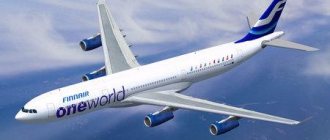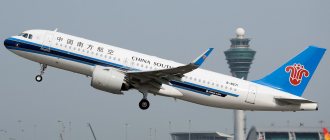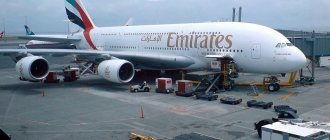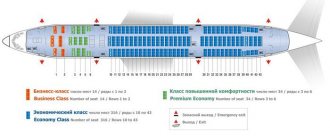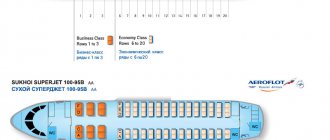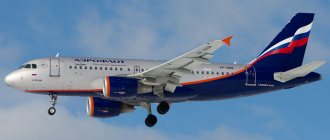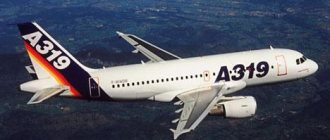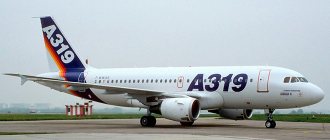Features of a330 300
Through the introduction of composite materials and modern lighter alloys, weight reduction was achieved, despite the lengthening of the vehicle's fuselage by 9,400 millimeters. Technologies developed for the Airbus A340-500 and 600 models have been introduced. The aerodynamic shape of the wing has been optimized, and power plants (engines) of the General Electric and Rolls-Royce brands have been used. This allowed the manufacturer to achieve the best combination: payload - flight range.
The aircraft is equipped with an EFIS electronic Avionics unit; instead of hydraulic or mechanical control rods, computer units controlled by electrical impulses have been introduced - instead of a steering wheel, the aircraft is equipped with control joysticks. All aircraft systems are computerized and duplicated.
Crew cabin
Main technical and operational characteristics of the aircraft:
- Wingspan - 60.3 meters;
- Length - 63.6 meters;
- Fuselage diameter - 5.64 meters;
- Crew - 2 people;
- The maximum number of passengers is 440 people.
- Cruising speed - 925 km/h;
- Flight range from 6,500 to 10,500 kilometers;
- The operational ceiling is 11,890 meters.
Models and modifications of the A330 airliner
Aircraft manufacturer Airbus produces A330 aircraft of different models, distinguished by fuselage length, total passenger cabin capacity and technical equipment.
Modifications of the A330 model:
- A330-100 is the first version of the airliner with a short fuselage and small passenger capacity. This model turned out to be unsuccessful, so the liner was quickly taken out of production and replaced with improved versions.
- The A330-200 is a popular model designed to carry 253 people in a comfortable two- and three-class cabin.
- A330-200HGW - the aircraft is built on the basis of the 330-200 model, but with an increase in maximum take-off weight to 5 tons.
- A330-300 is a model with a noticeably enlarged fuselage. On board can accommodate from 295 to 440 passengers, depending on the cabin layout.
- A330 neo - this model is a continuation of the popular Airbus line, designed on the basis of the new New Engine Option technology.
The company plans to soon release new Airbus models with improved technical and operational characteristics. The expected release of models 330-800 neo, 330-900 neo, as well as A330 P2F. In addition to civilian airliners, the aircraft manufacturer also produces cargo and military versions of the Airbus A330.
You may also be interested in – Airbus A320: description, cabin layout, operating air carriers.
The best places using Aeroflot as an example
Since the layout of seats in the aircraft cabin is different for each airline, for the convenience of readers, we will consider an example of a ship belonging to the largest Russian carrier,. The Airbus A330-300, the best seats of which we will now select with you, is used by the national carrier in three cabin configurations, and we took the most common option.
So, where is the best place to board the Airbus A330-300? The cabin layout shows us that in business class, the places where complaints may arise are the last and first rows. The first is due to the proximity of technical areas such as the kitchen, wardrobe and toilet. The latter is due to its proximity to the economy class, where more noise comes from where more people are accommodated.
In the 15th row of economy class, there are no windows at the side seats, which should be taken into account if you want to spend your flight contemplating the clouds and the endless sky.
The 29th row will be convenient for long flights - there are emergency exits nearby, there are no seats in front, so it will be very spacious to sit and lie there, you can stretch your legs and get up at any time without the need to wake up your neighbor. But it is worth considering the proximity of toilets. It can be heard from there, and standing next to people in line is unlikely to be very pleasant for anyone. Also, near this row, along with the 11th, there are mounts for bassinets, so get ready for babies to be next to you the entire flight.
The most uncomfortable seats are in rows 44-45 and 27-28. In addition to the proximity to the toilets, the backs of the seats in these rows do not recline - there is simply nowhere to go, since there is a wall behind them.
And finally, we note row 41, in which, due to a slight decrease in the width of the aircraft, two aisle seats stick out a little, which can create additional inconvenience.
Adviсe
The cabin layout of the Airbus A330-300 Aeroflot and the best seats, which you now know about, will help you buy a suitable ticket. Knowing the features of the seats in some rows, many people buy tickets, reserving the most comfortable seats in each class. Therefore, it is better to buy a ticket in advance, since as the departure date approaches, there are fewer and fewer good seats available. If you have any doubts about choosing a seat, you should contact an Aeroflot employee who will help you choose the best option.
Regarding the described configuration, if it is not possible to buy a business class ticket, it is still better to choose seats in rows 11 or 29. Unlike other places, there is no possibility that the neighbor sitting in front will recline his seat. If in other rows passengers are cramped, then in the 11th and 29th there is a lot of free space in front of the seats. Having a kitchen nearby is not a disadvantage since passengers in these rows get their food first. The only thing that can really disturb you during the flight is the crying of small children (due to the availability of bassinet seats, these seats are often occupied by passengers with infants). As for the presence of nearby bathrooms, the sounds of doors opening and closing can be heard here in the same way as in the neighboring rows. Therefore, when choosing, for example, between 11 and 12, preference should be given to the 11th row.
Of all the aircraft of this series that Aeroflot has, it is necessary to single out the aircraft with the number VQ-BNS. It has 36 business class seats and 265 economy class seats. The seats in economy class are more comfortable than those on other A330-300 aircraft. They are also equipped with additional sockets and footrests. A flight on such an airliner will be very comfortable, even in an economy class cabin.
Notes
Comments
- ↑ An airplane has 375 seats if it has 3 “type A” doors and 1 “type 1” door. If the plane has 4 “type A” doors, then the number of seats is 406.
- ↑ An airplane has 375 seats if it has 3 “type A” doors and 1 “type 1” door. If the plane has 4 “type A” doors, then the number of seats is 440.
Sources
- ↑
- ↑ 1 2 3 (undefined)
. Airbus.com (13 January 2014). Retrieved June 1, 2014. February 3, 2014. - ↑ (English). Airbus. Retrieved March 15, 2022.
- ↑
- ↑
- ↑ "." Flight International
. 14 March 2006. - ↑ Kingsley-Jones, Max. . Flight International
, 4 August 2009. - ↑
- ↑ (undefined)
. Retrieved July 21, 2010. February 15, 2012. - ↑ "dated February 21, 2009 on the Wayback Machine." Airbus
. 17 August 2006. - ↑ (undefined)
. ATW Online (August 16, 2010). Retrieved August 16, 2010. February 15, 2012. - ↑
- ↑
- ↑
- ↑ February 16, 2012.
- ↑ (unspecified)
(inaccessible link). Retrieved February 14, 2022. March 29, 2015. - ↑ November 3, 2012.
- ↑ (unspecified)
(inaccessible link). Retrieved July 17, 2012. July 12, 2012. - ↑ (Russian), AVIADO.RU - Portal about aviation and cheap air tickets
. Retrieved February 11, 2022. - ↑
- ↑
- ↑
- ↑ October 20, 2014.
- ↑ Kingsley-Jones, Max (unspecified)
.
Flightglobal
(20 May 2010). Retrieved October 7, 2013. - ↑. Airbus.com (2 December 2013). Retrieved on December 9, 2013.
- ↑ (inaccessible link)
- ↑ (undefined)
. Airbus SAS Retrieved November 20, 2012. - ↑ (undefined)
. Airbus SAS Retrieved November 20, 2012. - ↑ (unspecified)
(PDF) 42–51. Airbus SAS (1 January 2014). Retrieved July 6, 2014. - ↑ (undefined)
. Airbus SAS Retrieved November 20, 2012. - ↑ (undefined)
. Pratt & Whitney. Retrieved April 30, 2011. March 19, 2012. - ↑ 1 2 (undefined)
. EASA (22 November 2013). Retrieved May 16, 2014. - ↑ (undefined)
(PDF) 1–3. Federal Aviation Agency. Retrieved March 5, 2011. - ↑ Frawley, Gerald.
Airbus A330-200″, “Airbus A330-300 // The International Directory of Civil Aircraft, 2003/2004. - Fyshwick, Australia, 2003. - ISBN 1-875671-58-7. - ↑
- ↑
- ↑
Features of the 29th row
Many people think that row 29 is a great choice because of the amount of space up front, and that's true. You can easily get up from your seat without disturbing the passenger sitting in front. You can sit comfortably in a chair with your legs stretched out. However, there are also disadvantages here. Firstly, on the 29th row, which is the first in the business and all the others, which are the beginning of the cabin, it is forbidden to lay out hand luggage on an empty seat or under your feet, since these rows are mainly emergency.
There are toilets right in front of row 29, which means that passengers will not be able to sleep peacefully, as endless walking, slamming doors and an unpleasant smell will accompany them throughout the flight. Plus, people will crowd into the free space from the fatigue of sitting on a long flight.
Features of passenger seats in business class
The layout of the Aeroflot A330-300 cabin described below will allow you to determine the most suitable seats depending on the needs and wishes of the passenger. As an example, we consider the layout of an aircraft with a configuration of 28 business class seats and 268 economy class seats. The number and location of seats in other liners of this series are different, but the recommendations listed below will be relevant for each of them.
The front section of the cabin consists of 6 rows of business class. The chairs here are very comfortable. In them, passengers can easily endure a long flight. The backrests recline almost 180 degrees. However, even among these places there are some that can cause minor discomfort during the flight. We are talking about the first, fifth and sixth rows. The first row is located right next to the wardrobe. There is also a kitchen and toilets nearby. The fifth and sixth rows are located close to the economy class seats, where they are usually quite noisy.
Passenger cabin of the Airbus A-330
The classic version of the liner has two salons. The first six rows are reserved for business class. There are 6 seats in each row - two on the right, two in the middle and two on the left. The distances between the seats are quite large, which allows passengers not to interfere with each other. The seats here are very comfortable, they can be reclined 180 degrees, so you can get a good night's sleep during the flight.
This is especially important during night and/or long flights. However, it is important to keep in mind that rows 5 and 6 are noisy, as they are adjacent to the common salon
The remaining rows are reserved for economy class. It is divided into two compartments. Each row of the first compartment contains 8 seats - two on the right, four in the middle and two on the left. The seats in the middle are slightly shifted back. Toilets are located between the compartments. In the second compartment, the seats are located in the same way, only the seats in the middle are shifted forward, and in the last rows in the middle there are three chairs.
The best seats are considered to be the seats in the rows located immediately behind business class and behind the escape hatches. You can sit comfortably in the seats on the right and left. There are no neighbors in front, so no one will lean back on you. Having space allows you to stretch your legs and stand up without disturbing anyone. Moreover, there is a kitchen not far from these rows, and passengers occupying seats here receive food first.
When choosing places, consider the following important nuances:
For travelers with small children, it is better to choose the 11th and 24th rows, where there is space for the child’s accessories.
If you like to look out the window, then do not take seats in those rows where there are no windows. Check this information
The last row is especially noisy, and the seats are pressed tightly together due to the narrowing of the fuselage.
Story
Schematic representation of the A330
In 1972, the consortium began designing the A300 B9 wide-body aircraft, which was a stretched version of the A300 B2 with 322 seats. In 1973, the situation on the world market revealed the need for a more spacious aircraft, and the consortium worked on the A300 B11 project with four turbofan engines. In 1980, the project received the designation TA9 TA - twin aisle - “with two aisles”). In September 1982, the consortium announced that the new aircraft would have a common airframe design. In January 1986, the TA9 project was given the designation A330. Although the aircraft program officially began in June 1987, the A330/A340 long-haul aircraft program was launched to displace Boeing from its dominant position in the long-range passenger aircraft market. The originally planned versions 200 and 300 were almost identical: both models had the same wings, fuselages, controls; the models differed only in the number of seats. This solution made it possible, on the one hand, to reduce the cost of developing the aircraft, and on the other hand, it simplified and reduced costs for airlines in the operation and maintenance of aircraft. The Airbus A300 body, which was made longer, was taken as the basis for the development. The cabin (cockpit) was made similar to the A320 cabin. Thus, the resulting aircraft was a mixture of technical innovations from the Airbus A320 series with a fuselage from the A300/A310. The first presentation of the aircraft took place on October 14, 1992. Less than a month later, on November 2, 1992, the A330 in the “300” version took off for the first time. The third prototype was made with interior finishing and painted in the colors of the first customer - Air Inter - and was used as a sample for flight tests. In August 1993, ETOPS tests took place, during which the A330 flew over the North Atlantic for 6 hours with one engine running. Test flights were completed in December 1994 after all tests were successfully completed. Construction of a shortened version of the 200 was accepted in November 1995. And on August 13, 1997, this version made its first flight. The aircraft was handed over to the customer, ILFC, and its leasing partner, Canada 3000, on April 29, 1998.
Airbus intended to develop the A350 aircraft based on the A330 by replacing the wing, engines and modernizing the nose. However, the project was severely criticized by its main customers, and on July 17, 2006, at the Farnborough Air Show, Airbus presented a fundamentally new A350XWB project.
On July 14, 2014, Airbus announced[4] the launch of the development of updated versions of the family, which received the general designation .
History of the development of the Airbus A330 passenger aircraft
The development of the A330 began back in 1972. The European consortium needed to combat Boeing's dominance on long-distance international routes, including Europe-America routes.
In 1980, the designation twin aisle (with two aisles) was adopted, and in 1986 the new aircraft was given the name A330. Initially, two models were planned for launch - A330-300 and A330-200, which were almost identical, except for the number of passengers. This made it possible to reduce the cost of designing and testing aircraft.
Also, to speed up the design, the cockpit of the then advanced Airbus A320 was taken as the basis for the cabin. The fuselage of the new model was taken from the A300, only it was slightly lengthened.
The “roll-out”, that is, the presentation of the new aircraft took place on October 14, 1992, and the first flight of the aircraft took place on November 2, 1992.
The third side of the new model was already painted in the livery of the first customer “Air Inter” and served for full flight and static tests.
In August of the following year, the aircraft passed the test according to ETOPS standards (English: Extended-range Twin-engine Operational Performance Standards / Extended Twin OPerationS - Rules for extended-range flights by aircraft with two gas turbine engines). According to these rules, the aircraft must fly to the airfield in the event of an accident in the air, first 60, and then, when the standards are revised, 90, 120 or 180 minutes. It should be noted that this norm largely contributed to the problems during the launch of the IL-96 series developed by the USSR/Russia. As our designers said, that only we made a 4-engine aircraft that meets ICAO standards, as these standards were revised with a decrease in the number of engines. But the country has no longer had time to make a long-range twin-engine aircraft.
Turkish Airlines A330-300
After flight tests, the A330-200 program was revised to reduce the number of passengers and increase the flight range by lightening the aircraft and installing additional fuel tanks.
Later, Airbus tried to create a new type of aircraft, the A350, based on the 330, but due to consumer criticism it was forced to make it from scratch.
In 2014, the European consortium launched the development of updated aircraft, designated A330neo.
It is also impossible not to mention the A340 aircraft type, which is actually a four-engine modification of the A330.
Accidents and disasters
As of February 26, 2022, a total of 11 Airbus 330 aircraft were lost as a result of accidents and serious accidents[35]. They tried to hijack an Airbus 330 twice, resulting in the death of 1 person[36]. A total of 339 people died in these incidents.
| date | Board number | Disaster site | Victims | Short description |
| 30.06.1994 | F-WWKH | Toulouse | 7/7 | Test flight. Crew errors during engine failure simulation. |
| 15.03.2000 | 9M-MKB | Kuala Lumpur | 0/266 | Chemical corrosion of the fuselage during the illegal transportation of dangerous goods. Decommissioned. |
| 17.03.2000 | C-GGWA | Vancouver | 0/n.d. | During takeoff, debris that was not cleared from the runway was sucked into the engines. |
| 25.05.2000 | F-OHZN | Antipolo | 1/291 | Attempted hijacking. Having received the ransom, the hijacker jumped out of the plane and died. |
| 13.10.2000 | n.d. | Malaga | 0/158 | Attempted hijacking. |
| 04.12.2000 | n.d. | Bujumbura | 0/170 | During landing he came under fire from the rebels. |
| 24.07.2001 | 4R-ALE | Colombo | 0/0 | Destroyed as a result of an attack by the Tamil Tigers on the airport. |
| 24.07.2001 | 4R-ALF | Colombo | 0/0 | Destroyed as a result of an attack by the Tamil Tigers on the airport. |
| 24.08.2001 | C-GITS | Terceira | 0/306 | Made the longest glide of any jet due to a jet fuel leak. |
| 27.12.2001 | PT-MVB | Zurich | 0/n.d. | While being towed, it collided with an Avro RJ.100 Crossair. |
| 29.08.2005 | N855NW | Portland | 0/247 | While taxiing to the runway, it collided with a DHC-8. |
| 04.10.2007 | D-AERK | Dusseldorf | 0/125 | During takeoff, the engine was destroyed and aviation fuel leaked. |
| 07.10.2008 | VH-QPA | Indian Ocean | 0/315 | During a planned flight, he made two spontaneous dives due to a technical malfunction[37]. |
| 01.06.2009 | F-GZCP | Atlantic Ocean | 228/228 | Fell off the train due to erroneous actions of the crew due to incorrect readings from icy speed sensors. |
| 25.12.2009 | N820NW | Detroit | 0/290 | Attempted explosion. The hijacker detonated a bomb and was injured; the plane made an emergency landing. |
| 13.04.2010 | B-HLL | Hong Kong | 0/322 | Failure of both engines due to contamination of jet fuel. |
| 12.05.2010 | 5A-ONG | Tripoli | 103/104 | Crashed during landing in thick fog due to crew errors. |
| 17.12.2010 | OD-MEA | Paris | 0/n.d. | The tugboat lost control and took the plane in the wrong direction. |
| 13.04.2011 | F-GZCB | Caracas | 0/215 | Hard landing in harsh weather conditions. |
| 10.08.2012 | D-AIKE | Washington | 0/n.d. | While taxiing, he collided with a DHC-8. |
| 01.05.2013 | LN-RKO | Newark | 0/242 | Collided with an ERJ 145 on the taxiway. |
| 08.09.2013 | HS-TEF | Bangkok | 0/302 | Rolled off the runway due to a broken landing gear. |
| 07.10.2013 | RP-C3336 | Manila | 0/214 | It caught fire shortly after passengers disembarked. |
| 24.12.2013 | G-VNYC | Vieux Fort | 0/32 | Almost rolled off the runway when landing in the rain. |
| 29.06.2014 | 9M-MUC | Astana | 0/2 | Cargo flight. Damaged the wing when it collided with a lamp post while taxiing to the runway. |
| 15.07.2014 | 5A-LAS | Tripoli | 0/0 | Destroyed by a rocket during the fighting at the airport. |
| 20.07.2014 | 5A-ONF | Tripoli | 0/0 | Burnt down during the fighting at the airport. |
| 04.03.2015 | TC-JOC | Kathmandu | 0/235 | The front landing gear collapsed. Rolled off the runway. |
| 14.03.2015 | 9M-MTA | Melbourne | 0/n.d. | Hard landing. Received minor damage and restored. |
| 28.08.2016 | HL8258 | Seoul | 0/0 | Sustained damage to both horizontal stabilizers while being towed. |
| 01.10.2016 | B-18307 | Taipei | 0/137 | During landing, the tail part touched the runway. |
| 27.11.2017 | G-VRAY | NY | 0/n.d. | While taxiing to the runway, it collided with a Boeing 777. |
| 18.04.2018 | N806NW | Atlanta | 0/288 | Shortly after takeoff, engine No. 2 caught fire. |
| 13.05.2018 | HL7792 | Istanbul | 0/n.d. | While taxiing to the runway, the wing cut off the stabilizer of the A321. |
| 21.05.2018 | TC-OCH | Jeddah | 0/n.d. | After landing, the front landing gear collapsed. |
| 26.06.2018 | HL8286 | Seoul | 0/0 | Collided with a Boeing 777 while taxiing. |
| 31.10.2018 | F-GZCI | Paris | 0/n.d. | The tips of the wings collided. |
| N817NW | 0/n.d. |
Aircraft losses
A total of 8 A330 aircraft were lost.
| date | Board number | Disaster site | Victims | Short description |
| 30.06.1994 | F-WWKH | Toulouse | 7/7 | Engine failure simulation. Pilot error. |
| 15.03.2000 | 9M-MKB | Kuala Lumpur | 0/266 | Chemical corrosion of the fuselage during the illegal transportation of dangerous goods. The liner has been decommissioned. |
| 24.07.2001 | 4R-ALF | Colombo | 0/0 | Destroyed as a result of an attack by the Tamil Tigers on the airport. |
| 01.06.2009 | F-GZCP | Atlantic Ocean | 228/228 | Erroneous actions of the crew in the event of incorrect readings from icy speed sensors, stalling. |
| 12.05.2010 | 5A-ONG | Tripoli | 103/104 | Crashed on approach in thick fog |
| 15.07.2014 | 5A-LAS | Tripoli | 0/0 | Destroyed by a rocket during the fighting at the airport. |
| 20.07.2014 | 5A-ONF | Tripoli | 0/0 | Burnt down during the fighting at the airport. |
On August 24, 2001, an Air Transat A330-243 experienced the longest glide of any jet aircraft due to a fuel leak. This emergency situation arose as a result of wear of one of the fuel lines, which led to a fuel leak, and incorrect actions of the crew during the flight. In addition, the specific system for determining fuel consumption on the A330 contributed to the emergence of a dangerous situation - fuel consumption was determined by oil consumption. The pilots mistook the leak message for a computer glitch, failed to correctly assess the situation and began pumping fuel into the faulty fuel tank, which led to a complete loss of fuel and the shutdown of both engines. Ground services, to which the pilots turned for advice, were also unable to figure out the problem. The non-motorized flight lasted eighteen minutes, during which 120 km were covered, before an emergency landing at Lajes airbase (Azores, Portugal). As a result of the incident, passengers and the aircraft were not injured.
On October 7, 2008, a Qantas A330, tail number VH-QPA, was operating scheduled passenger flight 72, Singapore - Perth. There were 12 crew members and 303 passengers on board. In flight at an altitude of 37,000 feet, one of the three aeroinertial systems (air data inertial reference unit - ADIRU) began to provide incorrect flight parameter values to other aircraft systems. After 2 minutes, in response to an erroneous angle of attack signal, the flight control primary computer (FCPC) issued a dive command. The pilot immediately pulled the stick towards himself to correct the situation. The vertical overload reached −0.8 g. After another 3 minutes the situation repeated itself, but with less amplitude. It was not possible to determine the cause of the failures on board, and the commander decided to land the plane at the nearest airport. For the rest of the flight, the commander piloted the aircraft in alternative control mode (alternate law), guided by backup indicators. The further flight passed without incident, the plane landed at Learmonth airport. At least 9 crew members and 110 passengers were injured.
Becoming an airplane
In 1993, the Airbus 330 300 project was certified by American (FAR) and European (JAR) fitness standards. Unfortunately, in June 1994, during flight testing, a crash occurred while trying to work out an engine failure situation, killing 7 people.
From the release of the first production aircraft in 1994 to the present day, 8 aircraft are known to have been lost, 5 of which were taken out of service due to external factors (military operations, transportation of highly corrosive chemical materials). One aircraft was lost in 2009 due to speed sensor malfunctions, stalling over the Atlantic Ocean. Another crashed in 2010 in Tripoli while landing in heavy fog.
However, the reliability of the vehicle is confirmed by its adoption as a tanker aircraft in eleven countries around the world. The A330 MRTT has been used as a military transport and refueling aircraft in the following countries since 2005:
- USA;
- Saudi Arabia;
- UAE;
- India and others.
Now in the world, a total of 90 companies operate more than 950 Airbus 330 aircraft. The airliner is used by the most famous airlines in the world:
- American Airlines Group;
- Aeroflot;
- Deutsche Lufthansa;
- Air France-KLM;
- All Nippon Airways;
- China Southern Airlines;
- Turkish Airlines and others.
Interior modifications
The outstanding characteristics of the long-haul aircraft Airbus a330 300 make it an indispensable aircraft for long-haul passenger transportation.
There are three modifications of the interior with different degrees of comfort. The most common modification is to divide the aircraft into two classes: standard and improved seats, business and economy class, respectively. This aircraft can carry up to 335 passengers.
Next comes the division into three classes - first, business and economy. Capacity - up to 295 people. There are also solid economy class airliners. Such an aircraft is capable of carrying up to 440 passengers.
Flight comfort
Comfort here is created not only for passengers, but also for the cabin and flight crew. Therefore, the best seats on the Airbus A330-300 are not only business class seats, but also excellent lounges for flight attendants and pilots. After all, over long distances, the entire crew of an aircraft usually flies in a reinforced formation, and while some of them are resting, others are working. This room is located under the cargo compartment, and the descent is made via a special staircase located in the rear of the aircraft.
It is also possible to use the Wi-Fi service on board (if the option is additionally connected). Each backrest of the seat in front is equipped with an LCD screen on which you can watch movies and entertainment programs.
Flight performance
| A330-200 | A330-200F | A330-300 | |
| Crew | Two | ||
| Passenger capacity, typical | 253 (3-class)293 (2-class)375: (optional) 406 | 295 (3-class) 335 (2-class) 375: (optional) 440 | |
| Length | 58.82 m | 63.69 m | |
| Wingspan | 60.3 m | ||
| Wing area | 361.6 m² | ||
| Wing extension | 10.06 | ||
| Sweep angle | 30° | ||
| Keel height | 17.39 m | 16.90 m | 16.83 m |
| Cabin width | 5.28 m | ||
| Seat width | 18″ (457 mm) with 8-row standard economy or 16.5″ (419 mm) with 9-row high-density economy | ||
| Fuselage width | 5.64 m | ||
| Cargo volume | 136 m³ | 475 m³ 70 t / up to 12 accompanying people[24] | 162.8 m³ |
| Maximum take-off weight (MTOW) | 242,000 kg (530,000 lb) | 233,000 kg (510,000 lb) | 242,000 kg (530,000 lb) |
| Maximum landing weight | 182,000 kg (400,000 lb) | 187,000 kg (410,000 lb) | |
| Functional dead weight (typical) | 119,600 kg (264,000 lb) | 109,000 kg (240,000 lb) | 124,500 kg (274,000 lb) |
| Cruising speed | 0.82 M (871 km/h at 11,000 meters (36,000 ft) flight altitude) | ||
| Maximum cruising speed | 0.86 M (913 km/h at 11,000 meters (36,000 feet) flight altitude) | ||
| Maximum range when fully loaded | 13,400 kilometers (8,300 mi) | 7400 kilometers (4600 miles) 65t5950 kilometers (3700 miles) 70t | 11,300 kilometers (7,000 miles) |
| Take-off run at MVM (sea level, MSA, Rolls Royce Trent 772B engines[25]) | 2,770 m (9,090 ft) | 2580 m (8460 ft) | 2,770 m (9,090 ft) |
| Maximum fuel charge | 139,090 l | 139,090 l | 139,090 l |
| Flight altitude | 12,527 m (41,100 ft) | ||
| Maximum height | 13,000 m (42,651 ft) | ||
| Engines (×2)(see below) | General Electric CF6-80E1 Pratt & Whitney PW4000 Rolls-Royce Trent 700 | Pratt & Whitney PW4000 Rolls-Royce Trent 700 | General Electric CF6-80E1 Pratt & Whitney PW4000 Rolls-Royce Trent 700 |
| Traction (×2) | PW: 70,000 lbf (311 kN) RR: 71,100 lbf (316 kN)[26]GE: 72,000 lbf (320 kN) | PW: 70,000 lbf (311 kN) RR: 71,100 lbf (316 kN) | PW: 70,000 lbf (311 kN) RR: 71,100 lbf (316 kN) GE: 72,000 lbf (320 kN) |
Interior layout
Business class is located in the nose of the aircraft, behind the cockpit and dressing room. Seats in six rows. The seat layout is 1-2-1, there is also a 2-2-2 layout in which the passenger’s personal space is slightly limited due to the absence of partitions.
The fifth and sixth rows are not considered the best places due to the proximity of the economy class and the location of the mounts for baby bassinets behind them, which increases the noise level.
The first row is located in front of the kitchen, toilet and, accordingly, the dressing room, but the distance (on average 1,520 millimeters between the seats) allows you not to focus on the presence of people and service personnel in these places. Without exception, all business class seats fold out into a full-fledged comfortable bed
Business Class
By choosing business class, a passenger enjoys many advantages:
- flight comfort;
- expedited registration;
- separate entrance and delivery to the aircraft by a separate vehicle;
- flight attendants of the highest category;
- household appliances on board the aircraft;
- expanded selection of dishes;
- chairs with multiple modes;
Economy class has 35 rows and is located from the 11th to the 45th row. The seating arrangement is 2-4-2, in which a passenger needs to overcome one neighbor's seat as much as possible to enter the aisle.
Interior layout
The layout of the Aeroflot A330 300 cabin for economy class is practically no different from the layouts presented in other airlines.
The 11th row is most suitable for parents with small children due to the presence of mounts for bassinets directly in front of it and the widest possible legroom. The distance between the aircraft panel and the seat in the 11th and 29th rows is 890 millimeters, in contrast to the rest of the economy class seats, the distance between which is 790 millimeters. An important advantage is the absence of a neighbor in front; no one will recline the chair and thereby reduce personal space.
However, there is also a minus - the screens located on the panel of the aircraft do not turn off during the flight, even at night. There are emergency exits ahead of row 29.
Important! Tickets for the rows located near the emergency exit are not sold to children, the elderly and people with disabilities; it is also prohibited to place any things near the emergency exit that could interfere with emergency evacuation and animals. . The safest seats on an airplane are considered to be 4-5 rows from the emergency exit.
The safest seats on the plane are considered to be 4-5 rows from the emergency exit.
The disadvantage of the 11th, 29th, 44th and 45th rows is the close proximity to the kitchen, toilets and queues in them. There are no windows in row 15 due to the design of the aircraft. The recline of the seat backs in the 27th and 28th rows of the aircraft is limited compared to others. The backs of the seats in the 44th and 45th rows do not recline at all due to the close proximity of the kitchen and toilets.
Due to the narrowing of the fuselage of the Airbus a330 300 aircraft at the rear, seats in rows 41 to 45 are not only very close to each other, but also protrude into the aisles, narrowing them, which sometimes leads to collisions between people walking along the aisle and sitting in these rows.
The best seats (in terms of comfort and safety) in the economy class A330 300 are considered to be from the 24th to 26th row, as well as from the 30th to 33rd row. This review highlights the most common cabin layout in the Airbus a330 300. Aeroflot operates a small number of cabins that are slightly different from the standard; to see photos of such cabins, just type in a search engine - “Airbus 330 300 best seats aeroflot ru”.
In the passenger jet segment, the A330 300 is the most reliable and comfortable airliner. Considerable effort and expense have been invested in the convenience and entertainment of passengers. Almost all seats meet modern world passenger requirements, but some rows have organic comfort due to the structure of the fuselage and cabin equipment. Therefore, before purchasing a ticket, it would be a good idea to study the seating arrangement and determine all the pros and cons for your trip.
I Fly
Charter airlines use 4 layout options on their aircraft, each unique.
Seat map on the A330 at iFly No. 1
Classes are not highlighted. Total capacity - 387.
Seats at emergency exits: 36 A, C, H, K.
© iflyltd.ru
Seat chart No. 2
The first salon has 19 comfortable seats. The rest of the seats are standard, there are 268 of them.
Seats at emergency exits: 36 A, C, H, K.
© iflyltd.ru
Seat chart No. 3
The first 48-seat cabin has increased legroom in front of each seat. The rest of the seats are standard, 263.
Seats at emergency exits: 26 A, B, J, K; 39 B, J; 40 D, F.
© iflyltd.ru
Seat chart No. 4
The first cabin has a comfort class with 18 seats. The number of standard seats on the plane is 251.
Seats at emergency exits: 24 A, B, H, K.
© iflyltd.ru
